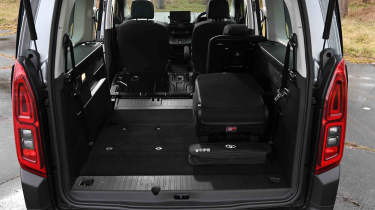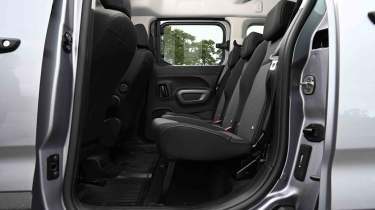There are digital dials on a 10-inch display, and these are also configurable, although options are limited. The trip computer is included here, with control via the end of the wiper stalk.
Expert view, on design
“Toyota has tried to give the Verso a smooth nose to emulate the likes of the C-HR and bZ4x, but it looks generic. The headlights are a strange mix of halogen daytime running lights and LED main lamps, so there are distinct yellow and blue tints to the supposed white light. It’s not obvious when you’re driving, though.” – Dean Gibson, senior road test editor, spent a week with the facelifted Toyota Proace City Verso.
Cabin versatility is the name of the game with van-based MPVs such as this

| Pros | Cons |
|
|
A van-based MPV is always going to deliver when it comes to practicality, and the Proace City Verso is a great choice for buyers needing lots of space. The cube-shaped body makes the most of the van’s dimensions, and there’s good room for passengers and luggage. The seven-seat version is based on the Long body, so that means the back seats aren’t crammed in and offer nearly as much room as those further ahead.
Dimensions and size
As you would expect from a platform-sharing enterprise, the Toyota matches its Citroen, Peugeot and Vauxhall relatives in terms of size, and all of them come in two lengths. Elsewhere, the VW Caddy/Ford Tourneo Connect are larger in every dimension, offering more overall space as a result. At the other end of the spectrum, the Dacia Jogger comes with a seven-seat layout, but in a more car-like shape that will demand more compromises.
| Dimensions | |
| Length | Short: 4,401mm, Long: 4,751mm |
| Width | 1,848mm |
| Height | Short: 1,812mm, Long: 1,818mm |
| Number of seats | Short: five, Long: seven |
| Boot space | Short: 597-983 litres, Long: 806-1,538 litres |
Driving position, seats & space in the front
The sense of space on board the Proace City Verso is enhanced by the tall roofline and large windows, while the driver’s seat adjusts for height to help with the view of your surroundings. Since the Toyota is derived from a van, there are plenty of storage spaces up front, including overhead shelves, a floor-mounted tray between the front seats, a shelf beneath a large glovebox, deep door bins, dashtop cup-holders and a lidded compartment above the dials.

Seats & space in the back
The middle row is designed for versatility, so they’re not the last word in comfort, but the three seats are the same size, so head, leg and shoulder space are all good. While there are door bins, there are no air vents, USB sockets or pop-out side windows. Unlike some MPVs, the seats don’t slide back and forth and are fixed in place.


